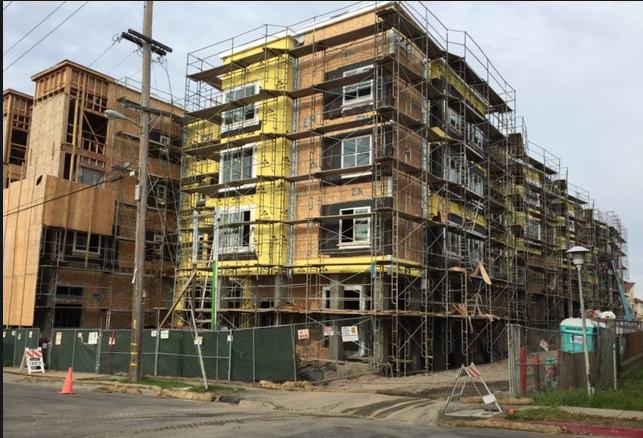
Ohlone Gardens, low-income housing in El Cerrito, Contra Costa County.
California Pioneers Subsidized Housing for Public Employees
Nothing about publicly subsidized affordable housing is affordable
By Edward Ring, December 3, 2019 2:25 am
Instead of building practical infrastructure and limiting zoning laws and building codes to practical necessities, they have institutionalized a system of rapacious yet totally legal corruption, masked by moral imperatives.
When it comes to affordable housing, what California’s state legislators have done epitomizes what happens when you have a government bureaucracy that serves itself instead of the public, one that is under the complete control of special interests.
They have enacted laws that have made it nearly impossible for the private sector to build homes, which has made homes unaffordable. Then to supposedly solve the problem they created, they brought in the public sector to build “affordable housing.” Their “solution” is a preposterous fraud that has already wasted tens of billions of dollars, and the worst is yet to come.
Nothing about publicly subsidized affordable housing is affordable. As a matter of fact, government funded “affordable housing” costs far more to construct than privately funded housing. But thanks to the politically engineered shortage of privately funded housing, and thanks to the result of this, a politically engineered and unaffordable price to rent or purchase homes, public housing is being sold to voters as a humanitarian necessity. And after the taxpayers foot the bill to construct this housing, taxpayers then foot the bill to subsidize the “affordable” rental rates charged the lucky occupants. Forever.
Subsidized housing developments were once known as the “projects,” which back in the 1960s were built as part of the “war on poverty.” These attempts at providing free housing backfired, as tenants with no ownership stake had no incentive to care for their property. But at least the projects were built cost-effectively. No such luck this time around. Certainly not in California. By the time the litigation has run its course, and the many expert consultants have taken their share, and the public bureaucrats have collected their fees, and the financial middlemen have been allotted their skim, the cost of these new public housing “projects” exceeds over $500,000 per unit.
From Flophouse to Bauhaus – Courtesy of Taxpayers
Critics of this astronomical price tag may relax, however, because affordable housing is no longer called “project” housing. It’s been rebranded! The new names, along with “affordable housing,” are “supportive housing,” “community housing,” and “municipal housing.” And instead of stark red brick mid-rise blocks of apartments, reminiscent of Ceaușescu’s proletarian barracks, today’s public housing may still be big boxes of concrete and steel, but they’re designed by visionaries, integrating “social justice” and “green design” into “transit oriented” utopias, replete with curved surfaces, a calming color palette, and “pedestrian paseos.”
The latest scam being foisted onto voters is called “workforce housing.” Never mind that government policies made housing unaffordable – let us borrow money to build subsidized housing for government workers. This new scam taps into a few reliable voter sentiments. Not only is this “affordable housing,” but it’s financed through a school bond which only requires a 55 percent vote to get approved vs. two-thirds for most other public bonds. This scam also taps into voter sentiment favoring anything to support schools and “the children,” as well as sentiment favoring helping our “public servants.”
Perhaps before providing some examples of this scam, let’s reiterate why it is a scam:
(1) Housing is unaffordable in California because government policies have made it impossible for private sector developers to construct affordable homes.
(2) Instead of changing these government policies, a coalition of public sector unions, crony developers, and financial intermediaries have decided to present voters with bond measures – already totaling tens of billions – to construct “affordable housing.”
(3) Due to the morally corrupt (but entirely legal) process costs – government planning and oversight, nonprofit service providers and partners planning and oversight, expert consultancy, litigation and settlement costs, financing costs, “green” compliance costs, “inclusion” compliance costs, project labor agreement costs, permits and fees, plus spectacularly expensive ongoing administrative costs – the total project cost per unit for these affordable housing projects actually exceeds what private development projects incur per unit, to the insufficient, limited extent those private projects are approved.
(4) Public employees are indeed unable to easily afford to live in the communities they serve, but that’s because everyone is unable to easily afford to live in these communities.
(5) It is alleged that representing “workforce housing” as eligible for the lower threshold of 55 percent voter approval because it’s a school bond may be illegal.
Bearing in mind that the first four reasons are reasons enough for this new practice to be a scam in every sense of the word “scam” (scam: “a dishonest scheme”), nonetheless, examples of #5 should be exposed. With help from Richard Michael, who for years has fought local government corruption and publishes (and perpetually updates) his website “BigBadBonds.com,” here are a few:
2018 Local California School Bonds that Included Funds for Workforce Housing
Pittsburg Unified School District, Measure P, $100 million
Jefferson Elementary School District, Measure U, $30 million
Palo Alto Unified School District, Measure Z, $460 million
Monterey Peninsula Unified School District, Measure I, $213 million
Pacifica School District, Measure O, $55 million
Perhaps we should be surprised that only five ballot measures of this nature could be found on local ballots in California during 2018. Then again, this is a whole new frontier of government expansion. Housing as not only a human right, but as an obligatory government entitlement, and never mind the fact that government policies made housing unaffordable.
Maybe the paucity of school bonds with “workforce housing” funding buried in the fine print is because it’s a new innovation. Or maybe it’s the fact that including “workforce housing” in a school construction bond is quite possibly illegal, since school construction bonds are for, imagine this, school construction. But the 55 percent threshold isn’t absolutely critical – three of these five were passed by over a two-thirds vote.
And what of bonds that require a two-thirds vote? How do they fare, and to what extent are these bonds offering “workforce housing”? A look at San Francisco’s Prop. A, which piled another $600 million in borrowing onto the tens of billions already spent by taxpayers to provide “affordable housing” and “supportive housing” offers a glimpse into the future. Because in Prop. A’s allocation of funds – which doesn’t unequivocally require a single unit of new housing, just rehabilitation of existing housing – is $20 million for “educator housing.”
San Francisco’s Prop. A was approved by 71 percent of voters.
Current California Housing Policies Are a Fraud
Across the state, voters have been conned into borrowing – against their future tax payments – tens of billions of dollars in pursuit of housing for the homeless, housing for low income residents, and, now, housing for public employees. All of this is a “dishonest scheme.” It is a monstrous fraud.
It is a fraud because the model being pursued will never solve the problem. By the latest estimates, California has over 150,000 homeless, well over 1.5 million state and local public employees, and at least 7 million people living below the poverty line. Shall all these 8.65 million people receive government subsidized housing?
A few basic calculations provides the answer: To provide “supportive housing” for all of California’s 150,000 homeless, even at $250,000 per unit – which is rock bottom and extremely unlikely to ever constitute the average cost – taxpayers would have to shell out $37.5 billion.
And what about “workforce housing”? Does anyone expect public employee unions to tolerate the lottery style allocation of subsidized housing to a select few, which is the process endured by low income families? One may rather expect these benefits to proliferate, finding their way into operating budgets as well as buried in bond measures. Again, even at a low-balled $250,000 per unit – taxpayers would have to shell out $375 billion.
As for “affordable housing,” it’s fair to say that the sky high home price equilibrium would be broken long before 7 million affordable housing units ever got built. But it’s also fair to wonder how on earth any private sector housing will remain in California – apart from plush high rise condos for the international investor class – when they’re competing with taxpayer funded developments at the same time as punitive laws continue to make it almost impossible to build without subsidies.
When it comes to housing, as with so many other things, California leads the nation. Instead of building practical enabling infrastructure and limiting their zoning laws and building codes to practical necessities, they have institutionalized a system of rapacious yet totally legal corruption, masked by moral imperatives.
It is a fraud of historic proportions, with incalculable cost and tragic consequences.
- Ringside: Ways California Can Have Abundant Water - October 31, 2024
- Ringside: Ways California Can Have Abundant Energy - October 24, 2024
- Ringside: Would Suing the Bureaucracy Bring Us More Water? - October 17, 2024





This is a cold-hearted, mean-spirited piece from an arrogant whiner who seems to have no concept of how hard and devotedly people in the low income housing sector are working to improve lives all across the country. I could refute each point, but why waste the time. While you, Ring, and your cronies try to lie and destroy our society, we will continue to try to house everyone.
Marty – with respect, it was not with a cold heart, but with cold facts, that this article was written. The single most relevant cold fact is this: The average cost of publicly subsidized housing in California is around $500,000 per unit. This is FAR more expensive than it ought to be, and “housing everyone” is NEVER going to happen at that price. If you want to make a difference, there’s a lot that can be done. For starters, repeal or reform the laws such as CEQA that make it so hard for private builders to construct new housing. To help the homeless, repeal the “housing first” regulations that make it impossible to require sobriety in exchange for shelter. There are shelters that aren’t eligible for public funds (because they require sobriety) that assist people for a fraction of the price of publicly funded shelters, and have far better success rates at getting people back on their feet.
You are invited to refute any of the points made in this article, or others on the topic. These reports were written after talking with dozens of people directly involved in coping with the homeless crisis in California as well as people affected by it. The way California’s elected officials are currently trying to increase the supply of housing in California is an extreme waste of money, and will never solve the problem.
I’ve followed public sector unions and their political allies for years, and Marty Bell’s comment epitomizes the party line. If we don’t agree with everything they say and do, we are against them. Building housing solely for public employees smacks of prejudice against private sector workers who also need homes. Let’s look at the big picture, not just the one through public union eyes. Grow up.
As long as someone buys it or rents it, it is affordable. Market forces control affordability. Government housing projects are something else entirely.
No such things as “unaffordable housing” – only mismatches between skill sets and housing market prices.
Housing is a commodity; not a right.
You can’t tear down houses in one part of this country, and then claim there is no housing in others. There might be a location mismatch; but there is no lack of housing in this country.
Zillow surf and all you see are highly affordable homes for sale all over this country – even affordable to SSI recipients. Trona California is a prime example. No sympathies for anyone whining they can’t afford to buy a house.
They just turn their noses up on what they can afford. Not my problem.